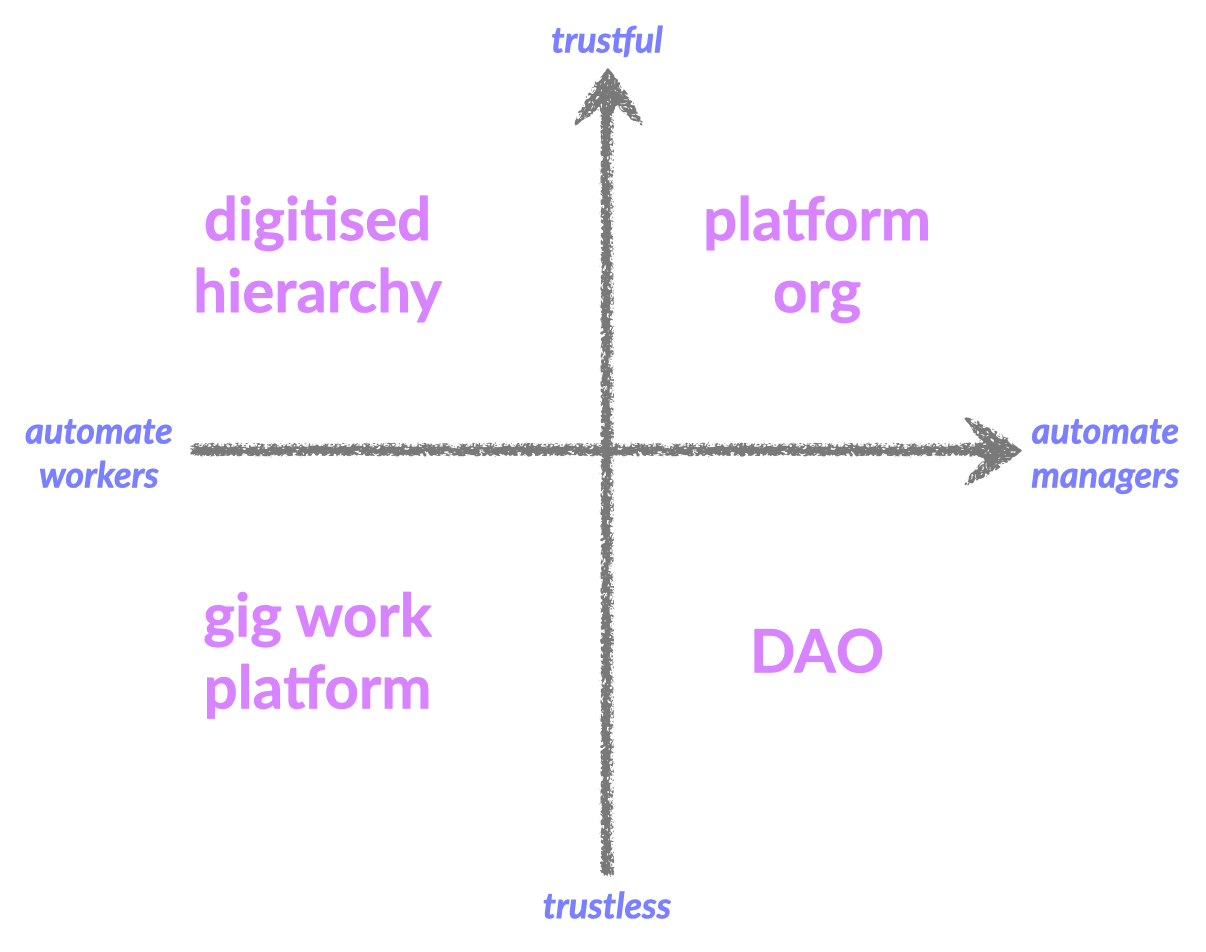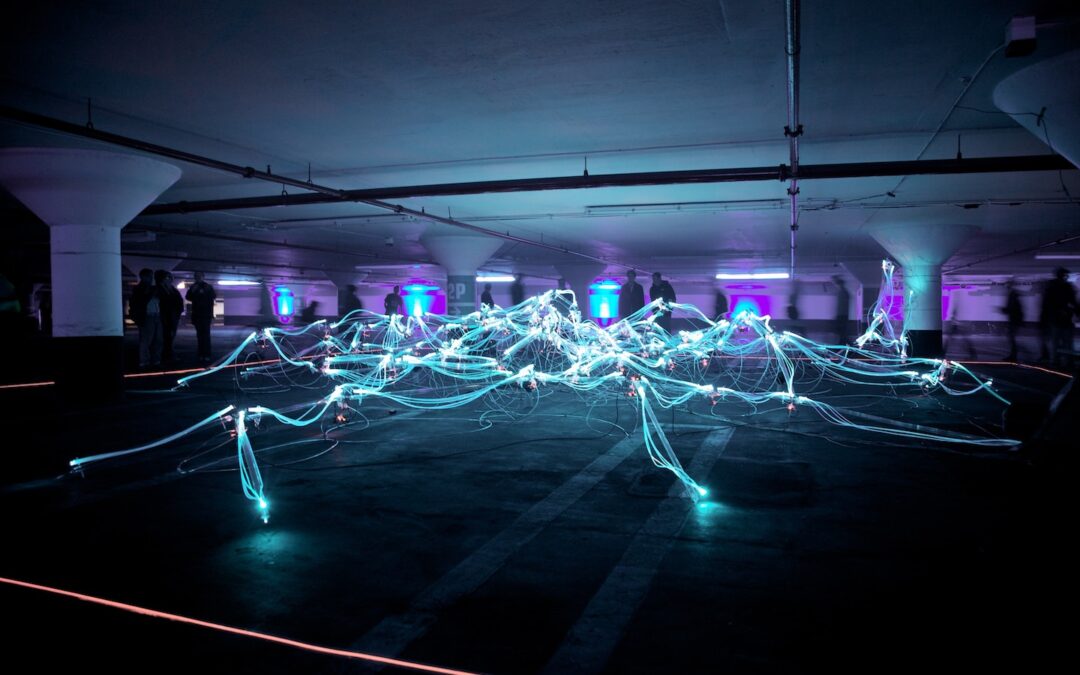Lee Bryant reflects on divergent visions for the future of the digital organisation.
Towards digital organisations in 2022 🎉
2022 looks set to be a year of divergent visions of what a digital organisation means and how it is organised. Most things that matter in life come down to how people relate to each other, collaborate, cooperate or compete in pursuit of their goals. Throughout history, various group structures and shapes have evolved to govern collective action, on a spectrum from coercion to collaboration. The rise of the internet created the possibility of coordinating work in much more efficient ways than hierarchical management, and without its damaging caste system; but changing the system is hard when a century or more of business innovation has grown up around the trunk of the management hierarchy tree. The pandemic has accelerated the shift to remote, online-first working, but it has not yet fundamentally changed the model. The good news, at least based on my own experience of leadership development, is that emerging leaders in many organisations are less motivated by the appearance of status than they are by the urgency to create successful future-fit firms, so I am hopeful they can be the transitional generation that reforms and reduces the management ball-and-chain holding us back. But there are several, quite distinct directions coming into focus for what flavour of digitally-enhanced organisations emerge from this transition, and they embody quite different values and attitudes towards inter-personal relations and collaboration. This matters because, if we are not careful, we risk repeating some of the mistakes that saw the early promise of Web2.0 turn into the toxic world of Facebook and Twitter.
Trustless vs trustful systems
Trust and scale are very important concepts when it comes to social networks and how we engage with each other. Our brains are wired for small-world inter-personal trust, and we do this pretty well; but we can be easily deceived by mechanisms that pretend to be proxies for trust, such as brands or in the case of Web2.0 the idea of a ‘global village’ community comprised of people who don’t care to know much about each other. The rise of so-called trustless systems – where people are invited to trust code or systems instead of each other – is hard to ignore right now, with blockchains, crypto coins and also new structures such as Distributed Autonomous Organisations (DAOs). This is one solution to the challenge of scaling trusted relationships, but highly susceptible to exploitation by bad actors, as the whole field of crypto coins and tokens demonstrates day after day. So what might the impact of trustless systems be on digital organisations, and what are the alternatives? One way of categorising approaches to digital organisations is to look at them on two axes:
- trustless vs trustful systems; and,
- systems that automate managers vs those that automate workers

Divergent visions of digital work systems
The gig worker platform approach pioneered by Uber is a trustless system of work coordination where the platform and its algorithms mediate relations with independent contractors or drivers, commoditising their workforce. It has scale advantages for the firms who use it, and some gig workers welcome the flexibility it offers, but this model has been widely criticised for driving a coach and horses through common notions of worker rights, and creating negative externalities that are not accounted for by the firms themselves. The Distributed Autonomous organisation (DAO) is a trustless system for allowing weak or no-tie networks of people to govern an organisation that in theory does not require managers. The idea of reducing the common purpose and shared experience of work relationships to a purely transactional form has the same potential for harms and exploits that we saw in both adtech and the crypto gold rush. If code is law and we can trust it to handle every complexity of human interaction, then there is no ethical barrier to exploitation or theft if you are smart enough to find a loophole. And of course, if you buy up voting rights just as post-Soviet oligarchs bought up workers’ shares of privatised state firms, shadowy ‘whales’ can easily ‘own’ an apparently de-centralised system, just as we have seen with various crypto coins. At the risk of sounding like a Gen X pre-Facebook Web2.0 idealist, I believe the goal of technology is to enhance, augment and connect human relationships, not to mediate them through token-sale Ponzi schemes. I mean, yes, we use money to keep score sometimes in business, but most decent people are slightly more multi-dimensional than that might imply. So what do trustful, rather than trustless, approaches look like – systems that help us share more social surface area to build and evaluate human trust? Perhaps the default approach for many organisations will be to digitise hierarchical management whilst automating so-called low-end jobs to commoditise workers, perhaps with more gig working or contract working thrown in. It is entirely possible to imagine running firms in finance, banking, professional services and even manufacturing and production where the only protected and well-remunerated staff roles are office-based managers, and most other functions are offloaded to contractors, automated or outsourced. But this model risks making the management productivity problem worse, and might not be an attractive enough proposition for next generation of digital talent that firms need to evolve. In my view, the best architecture for a modern, digital organisation that wants to create a space for trustful collaboration whilst commoditising managerialism (in the basic sense of work coordination as opposed to value-additive leadership) rather than workers, is still the platform organisation model that has been growing in popularity over the past decade as a blueprint for digital transformation. This model commoditises routine tasks and functions as automated digital services that are made available via a platform, on top of which autonomous, agile teams and loose networked structures are free to build offerings from the services below, safe in the knowledge that compliance, security and the rules of the road are baked into how they work. Just like iOS or your TV’s Web OS, most people can’t mess with the core platform, which is conservatively managed, but enjoy almost infinite variety in the ‘apps’ or functions they can use on top. If we think of last generation pre-digital organisations as inefficient process management machines made of people, the platform model can support organisations that are simultaneously more machine-like at the back-end (automation, SOA, etc) but more human at the front-end, where people create innovative experiences based from the basic services, data and algorithms below.
A debate that is just getting started
Time will tell and – as with crypto – many analysts who see the downsides will be swept along in the torrent of Web3 hype either due to FOMO or because there is money to be made. But the introduction of tokenised governance to the field of digital organisations reminds me of the way in which the adtech-driven high-scale / low-trust models of Facebook and Twitter ruined the small-world potential of social media back in the day. Here is a selection of other perspectives on this topic:
- Moxie’s crypto critique and a repo of others
- The story of the first DAO
- Dion Hinchcliffe on Why Web3 matters
- Colony’s token sale and DAO-builder
- Boundaryless on platforms and the 3EO model

